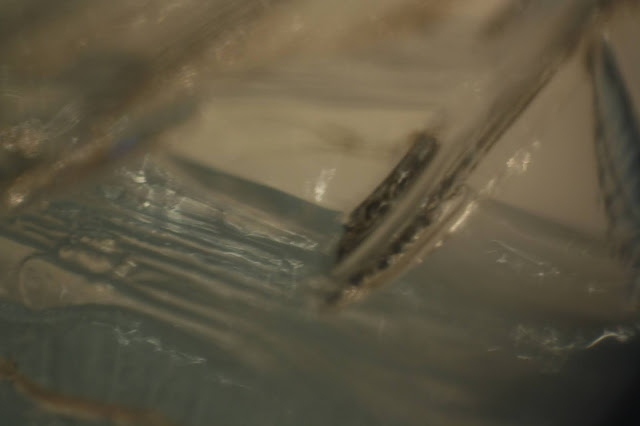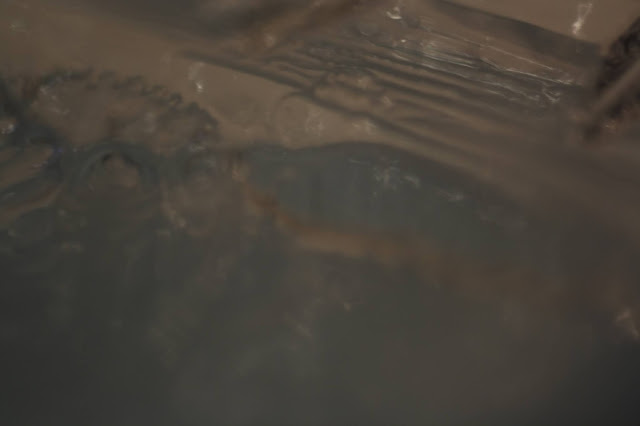STONEHOUSE
To glimpse the fluttering of shy birds I don’t always
close the door I made
A piece of jade is worth more than a cliff but gold can’t
buy a lifetime of freedom
The sound of icy falls on a dawn-lit snowy ridge the
sight of distant peaks through leafless autumn
woods mist lifts from ancient cedars and clear
days last forever right and wrong aren’t found in
the clouds.
Despite having hold two influential posts during his life he spent most of his adult existence as recluse in the mountains. Here he wrote his poems during his last years.
The translation is by Red Pine.
Um einen flüchtigen Blick zu erhaschen auf das Flattern
schüchterner Vögel, schließe ich nicht immer die
Tür, die ich gemacht habe
Ein Stück Jade ist mehr wert als ein Felsvorsprung aber
für Gold kann man kein freies Leben kaufen
Der Klang vereister Wasserfälle auf einen von der
Dämmerung erhellten Grat die Ansicht ferner
Gipfel durch blätterlosen Herbstwald Dunst steigt
auf von alten Zedern und klare Tage dauern ewig
richtig und falsch lassen sich nicht finden in den
Wolken.
Das ist das Zentrum von STONEHOUSE, dieses Gedicht. Aber Stonehouse ist auch der Name des Poeten (1272 - 1352). Er lebte inmitten von Bergen und Wäldern, wurde aber Stonehouse genannt, nach einem Felsen in der Nähe seines Heimatortes, groß wie ein Haus, aus dem eine Quelle entspringt.
Als junger Mann hatte er seine Studien abgebrochen, um Mönch zu werden. In mittleren Jahren bot man ihm den Posten des Meditationsmeisters in einem renommierten Tempel an. Er nahm an, aber kurze Zeit später wurde ihm klar, dass er die Berge vorzieht. Also verließ er den Tempel.
Nachdem er dann über 20 Jahre als Einsiedler gelebt hatte, wurde ihm erneut ein bedeutender Posten angeboten, diesmal als Abt eines Klosters. Aber nach einigen Jahren bat er erneut um seine Entlassung.
Obwohl er also zweimal während seines Lebens einflussreiche Posten innehatte, verbrachte er den Großteil seines erwachsenen Daseins als Einsiedler in den Bergen. Die Gedichte entstanden dort während seiner letzten Jahre.
Ins Englische übertragen hat sie Red Pine.
Stonehouse, das klingt solide und wie fest verankert in der Wirklichkeit. Aber der äußere Schein trügt: So wie die Beobachtungen des historischen Stonehouse, nüchtern und diesseitig, ihm dennoch die Unterscheidung zwischen richtig und falsch verweigern, verbergen auch die Töne ihre wahre Herkunft.
Stonehouse, this sounds solid and like firmly established in the reality. But the appearences are deceptive. Just as the delineations of the historical Stonehouse, sober and this-worldly, nevertheless withhold him the discrimination of right and wrong, the tones also hide their true origin.
While CHLADNI OU LE GALBE didn’t offer a single attack, STONEHOUSE goes the extra mile: here there is but reverberation. The “materiality” of the tones becomes an inkling. That is to say the origin of the tones is acoustic, presumably real, what you can hear though is artificial or illusionary. Shards of former pieces generate the sounds of STONEHOUSE. So you listen to reminiscences of the portative, melodion, flute and - after the poem, a little bit more fidgety, rougher - prepared piano.
The words of Stonehouse are joined by “real” tones of a monochord. Although it´s not real as instrument but a teaching material to display and render audible the mathematical and physical relations between tone intervals.
Clouds in time-lapse (at accelerated speed), the coming and going.
Während in CHLADNI OU LE GALBE kein Ansatz zu hören war, geht STONEHOUSE noch einen Schritt weiter: hier gibt es nur noch Nachhall. Die Materialität der Töne wird zur Ahnung. D.h. der Ursprung der Töne ist akustisch, vermeintlich real, das zu Hörende aber künstlich oder illusionär.
Bruchstücke aus CHLADNI OU LE GALBE und BENTHOS generieren die Klänge von STONEHOUSE. Man hört also Reminiszenzen von Portativ, Melodion, Flöte und - nach dem Gedicht, etwas unruhiger, rauer - präpariertem Klavier.
Zu den Worten von Stonehouse gesellen sich dann „reale“ Töne eines Monochords. Allerdings ist auch das nicht »real« als Instrument, sondern eine Art Lehrmittel, um die mathematischen und physikalischen Beziehungen zwischen Tonintervallen darzustellen und hörbar zu machen.
Wolken im Zeitraffer, Kommen und Gehen.
Wie im Gedicht geht es auch in der Musik darum, dass Erscheinungen Freiheit vermitteln, nie aber die Frage nach richtig und falsch beantworten können, so real sie auch wirken mögen.

Like in the poem, in the music too it´s about how appearences convey freedom but never can answer the question of right or wrong, no matter how real they seem to be.
The photos show a Stonehouse too, in parts. And though it’s much bigger, more elegant and sophisticated, naturally not only like the cage but also like the hut, timewise and at times too it’s closer to the hermit then to nowadays. I did the photos last summer in Mantova, in the Palazzo Ducale, manorial seat of the Gonzagas over centuries, one of the most influential family of Italy, with frescos from Andrea Mantegna and apparently about 1000 rooms.

Die Photos zeigen ebenfalls ein Steinhaus, in Teilen. Und auch wenn es viel größer ist, eleganter und verfeinerter, natürlich nicht nur als die Höhle, sondern auch als die Hütte, ist es zeitlich und auch zeitweise näher am Eremiten denn an Heute. Ich habe die Bilder letzten Sommer in Mantova gemacht, im Palazzo Ducale, Herrschaftssitz der Gonzagas über Jahrhunderte, einer der einflussreichsten Familien Italiens, mit Fresken von Andrea Mantegna und anscheinend um die 1000 Räumen.
Kommentare sind wie immer willkommen.
mail@stefan-hardt.de
Alle erwähnten CD´s und noch viele mehr sind entweder bei mir direkt oder bei Bandcamp bestellbar (stefanhardt.bandcamp.com).
Commentaries are always welcome.
mail@stefan-hardt.com
For all mentioned cds and many more please contact me or bandcamp
(stefanhardt.bandcamp.com).



























